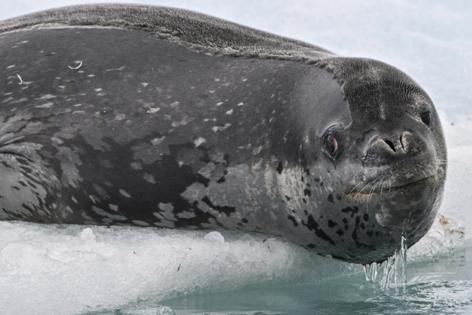What do leopard seals eat in Antarctic waters? Whiskers provide surprising answer
Published in News & Features
From a dish made by your hometown restaurant to candy you searched for on Halloween, most people have an all-time favorite food.
Humans are omnivores with a diverse diet, but there is still a large amount of individuality when it comes to food choice.
Now, researchers are learning that other creatures in the animal kingdom may feel the same way.
A research team led by Baylor University and the University of Rhode Island took a closer look at one of Antarctica’s apex predators to better understand their feeding preferences in a study published June 23 in the peer-reviewed journal Ecology and Evolution.
Leopard seals have long been thought of as “generalist” predators, feeding on both penguins and other seal species as well as fish, krill, octopus and squid, according to the study.
On one island off the Western Antarctic Peninsula, leopard seals eat as many as 70% of Antarctic fur seal pups each year, severely impacting their declining population, researchers said.
The team noticed, however, that there were many other prey options for the leopard seals in the same geographic area, which made them wonder whether despite being generalist hunters, individual animals were showing prey specialization, according to the study.
To test the theory, researchers analyzed the isotopes in the individual whiskers of leopard seals to identify their prey sources over a period of multiple years, according to a June 24 news release from the Georgia Aquarium, which was involved in the study.
Leopard seals were sedated and their whiskers collected over a period of 10 years until 2023 through the U.S. Antarctic Marine Living Resources Program monitoring the ecosystem at Cape Shirreff on Livingston Island, according to the study.
Researchers measured the amount of nitrogen and carbon in the whiskers, which tells them the kinds of animals the leopard seals have eaten in the past few years. Both nitrogen and carbon concentrations increase as they move up the trophic levels, or the food chain.
For example, if a fish has a small amount of nitrogen, but then a seal eats many fish, the seal’s percentage of nitrogen will be higher, indicating their place on the food chain in what is called bioaccumulation.
A total of 34 leopard seals were included in the study, and their analysis yielded “surprising” results, the aquarium said.
“The researchers found that while some seals maintained the same diet year after year, others switched trophic levels — moving between eating smaller prey like krill and targeting larger animals like penguins or seals,” according to the release.
In total, 87% of the leopard seals were what researchers called “specialists or intermediates,” meaning they stuck to a smaller selection of prey than they were capable of eating, while only 13% of the leopard seals were considered true “generalists,” according to the study.
Researchers suggest this may be to decrease the amount of competition between leopard seals if they are not overlapping prey, according to the study, but this puts a significant strain on individual prey species that have become leopard seal favorites.
“A few specialists can help shape entire ecosystems,” study author Patrick Charapata of the Georgia Aquarium said in the release. “Understanding these patterns in leopard seals and other top predators can help us better predict and manage changes to prey populations and the greater ecosystem these species live in.”
The Western Antarctic Peninsula is south of South America, across the Drake Passage.
The research team includes Charapata, Emily S. Sperou, Douglas J. Krause, Renato Borras-Chavez, Daniel P. Costa, Daniel E. Crocker, Kerri J. Smith, Bradley Thompson, Azana Best, Jaelyn Anderson, Michael E. Goebel, Carolina A. Bonin and Sarah S. Kienle.
_____
©2025 The Charlotte Observer. Visit charlotteobserver.com. Distributed by Tribune Content Agency, LLC.







Comments